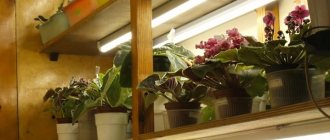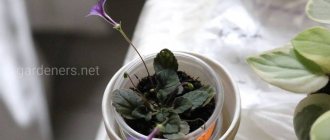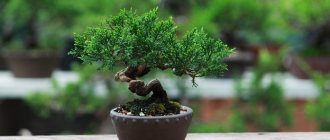To grow flowers at home, you must follow the rules: timely watering, choosing high-quality soil, and a suitable pot for growing flowers. Most plants do well in any type of soil. But there are also flowers for which special conditions must be created. These include violets. In order for these wonderful flowers to grow and smell fragrant on the windowsill, you need to properly care for them. Particular attention should be paid to pots for violets, on which the health of the flowers depends.
What pots are needed for violets?
When choosing which pots to plant violets in, you need to select ceramic and plastic products. Metal, cardboard, and glass containers are not suitable.
Cut-off bottles and plastic cups are also a bad choice because they not only look unattractive, but can also become moldy over time.
Size and volume
It is not recommended to purchase containers that are too small. The root system of the plant grows quickly, there will not be enough nutrients in the soil, and replanting will be required. Since violet roots do not grow deep, but to the sides, you will need a product with a large diameter.
Plastic glasses can be used to transplant leaves from which a daughter plant is grown. In other situations their use is not suitable due to their too small size.
Since the roots grow to the sides and do not go deep into the soil, purchasing a deep container is not necessary. The root system is always located close to the surface, even in wild violets.
You should not purchase pots that are too large. The bush may grow in them, but will stop blooming. You should not keep several violets in one pot: this can lead to the death of all the flowers; Flowering often stops in all Saintpaulias. Large pot sizes are allowed only in situations where a mother plant intended for breeding is grown.
For an adult plant, it is better to choose large pots. The diameter should be 9 cm, and the depth should be the same. If the container becomes insufficient for the violet, you should not buy a larger one: you need to take out the Saintpaulia, carefully shake off its roots from lumps of earth, and then plant it in a product of the same diameter.
If Saintpaulia is of medium size, a pot diameter of 7 cm with the same depth dimensions would be suitable.
For small plants, you should select a smaller container: the volume of the pot should be proportional to the size of the flower.
The optimal width for a violet pot is considered to be 3 times smaller than the diameter of the rosette. Only in cramped conditions will flowering be abundant.
Plastic
Plastic pots for violets may have bright colors and look good in the interior, but the material can be toxic to the root system of the flower. It is allowed to purchase products made of high-quality plastic; It is recommended to avoid those that are too cheap.
Plastic pots work better. They are flexible, lightweight, and will last for a long time. Thanks to its flexibility, it is easy to transship. The only negative side of this choice of container for growing violets is the difficult passage of oxygen through the dense walls. This problem can be solved by making several holes in the bottom and side surfaces.
Ceramic
It is better to choose ceramic pots with glaze: they are more durable and their service life is longer than those without such a coating. Difficulties also arise with the passage of air inside: it is not easy to make a hole in dense ceramics. When purchasing, you need to check for holes in the bottom. The disadvantage of this choice is the large mass of the product: it will be difficult to constantly carry it; if the size of the violet pot is large, it will not be possible to install it on glass shelves. It is believed that Saintpaulia develops better in ceramic products than in other containers.
Clay is also considered a good choice - the natural material allows air to pass through well, so the violet does not need additional holes in the pot.
Pests and diseases are rarely observed in plants grown in such containers. The disadvantage of clay is its fragility and heavy weight. Clay absorbs water and dries out the soil. In addition, this material quickly heats up under the rays of the sun, causing the soil to dry out; This feature should be taken into account when choosing the frequency of watering.
Can you use clear pots?
Transparent products are convenient for examining the root system. You can monitor the condition of the soil for violets, water it in a timely manner or loosen it if necessary. Low cost is also an advantage. The disadvantage is that the appearance is not very attractive; To disguise an ugly container, you will have to put it in a flowerpot.
If you plant flowers in transparent containers, pay attention to the material. Glass is not suitable for violets. Plastic can be toxic.
Nuances of choosing a flowerpot
When choosing a pot for indoor violets, do not forget about the specific growth of Saintpaulia roots. Violet roots grow close to the surface and develop poorly in length.
Over time, a new root system forms on the stems after the lower leaves die. In their natural environment, violets grow in rocky soils and for the best development of the plant it is necessary to provide maximum air access to the roots.
You should not transplant a standard violet into a pot larger than the maximum recommended size.
If replanting is necessary, you need to remove excess soil and dying roots and replant them in a pot of the same diameter. If a larger pot is selected, several problems may arise:
Use the following tips when choosing what size pots should be:
How to make it yourself?
When choosing which pots to grow Saintpaulias in, many people prefer homemade containers. They are cheaper, made from natural materials that do not contain foreign impurities that can harm the plant.
To make it you will need to take clay. You will need a potter's wheel and a kiln. Using a circle, the container is shaped into the desired shape, then fired to make it more durable. After this, if desired, you can paint the resulting product.
Plaster will also work. You should find a suitable form in advance. The powder is diluted in water, after which the resulting mass is poured into a mold and left there until it hardens completely. Then the resulting container is removed. The disadvantage is that it is not resistant to moisture: after a while, a homemade pot may become unusable. In addition, gypsum products break easily when dropped.
You can also weave a flower pot from twigs. These pots for violets in the photo turn out well, can last a long time, are resistant to moisture and allow air to pass through well. The disadvantage of this product is the difficulty in manufacturing: the work will require a lot of time and skills.
Preparing for planting at home
Step-by-step instruction
After thoroughly preparing the soil, you should begin preparing the tubers for planting. If during the dormant period they were located in an old pot, they need to be taken out, cut off the old roots and be sure to rinse with water (we talked about the peculiarities of wintering gloxinia here). If there is any damage on the surface of the tuber, it should be cut off immediately with a knife.
To prevent further rotting, you can immerse the tubers in a solution of a fungicidal agent, for example, phytosporin, for half an hour. You cannot plant them immediately after such an operation - you need to dry them for about a day. A tuber ready for transplantation should be smooth and hard (you can find out how to transplant and grow gloxinia here).
A drainage layer no more than three centimeters high (foam plastic, expanded clay) must first be placed on the bottom of the pot. Pour pre-prepared soil on top, which you should try not to compact, leaving it quite loose. In the center you need to make a slight depression where you need to place the tuber itself. Then sprinkle it on all sides with soil so that 2/3 of it is immersed in the soil.
To prevent the plant's tuber from rotting, you need to moisten the soil so that water does not get into the center and onto the sprouts. In order to create the most favorable microclimate for germination, you need to put a transparent plastic bag on the pot and place it in a brighter place. To ventilate, once a day you need to remove the bag from the pot for 15-20 minutes. As soon as the first pair of leaves appears, you can close the bag only at night, and after a few days remove it completely.
Below is a visual video about planting gloxinia tubers:
The Scarlet Flower
“Scarlet Flower” produced in Russia is convenient for plants, when watering which it is necessary to avoid getting liquid on the leaves: violets, streptocarpus, orchids. The product is well suited for bottom watering. The system consists of 3 parts made of plastic. From 2 parts you need to make a tray into which liquid for irrigation is poured. In the third, equipped with a large number of small holes, Saintpaulia is planted.
When choosing which pots for violets to purchase, you should take into account that the size of such a product is small and is better suited for young plants.
When planting, the rosette should not be buried in the soil mixture. There is no need for drainage. The container with Saintpaulia is located 1-1.5 cm above the tray. It is not difficult to remove the top part. “The Scarlet Flower” is easy to use and can serve for a long period of time.
Planting Saintpaulia - choosing the “right” leaf
The subsequent survival rate of Saintpaulia and its further growth will directly depend on how correctly you can choose a leaf for propagation. Moreover, the quality of the color, or more precisely, the size of the bud and the color of the petals, depends on the planting material. It is necessary to select only healthy leaves, mainly from the third row (you can also take from the second if the plant is not too “old”)
Pay special attention to possible plant diseases, including spotting, powdery mildew and pests - often the leaf blade becomes a habitat for fungus or parasites
As for size, you should choose only dense, medium-sized leaves, since leaves that are too small do not have enough minerals and organic substances for a good “start.”
Color plays an important role when choosing. As you know, the main indicator of a large amount of accumulated chlorophyll is the dark green color of the plate. If they are yellowed, then there is nothing to hope for an excellent bush - basically it dies even before rooting begins. Even if this does not happen and any activity occurs, there may be no new children - the bush will remain dormant for a long time.
Pots for wick watering
For wick irrigation, you should not purchase heavy ceramic and clay containers: the weight of the structure itself is large. As a reservoir, it is better to choose a plastic pot, the bottom of which has several holes. Since the loose substrate can easily spill out, it is necessary to cover it with a well-permeable fabric: line it with a gauze bandage or a thin synthetic rag.
It is recommended to purchase a special container for the liquid to ensure proper functioning of the system. If it is not possible to purchase it, the use of plastic containers is allowed. The container is tightly covered with a lid, after which a hole is made in it where the wick is inserted. The pot with Saintpaulia is placed on top. The wick must be lowered into the water.
The wick must be made of synthetic material. Natural ones are not suitable: due to high humidity they will quickly begin to rot. You should not choose a cord that is too thick: options with a thickness of 1.5 to 5 mm are considered optimal. The length should vary from 15 to 20 cm.
Choosing material
Available plastic and plastic
Great option! The plastic is flexible (which means it is convenient to press on the pot when removing the plant for handling), lightweight, and durable. And if you plant flowers in yogurt jars or cut-out plastic bottles, you will get the container for free.
There are some disadvantages to plastic/plastic pots. For example: they do not breathe, that is, they do not allow air to pass through. And so that the roots of Saintpaulia receive enough oxygen, make sure that in addition to the holes in the bottom of the pot, the violet also has a tray with a ribbed bottom.
Place the pot on these ribs, and they will allow the air the flower needs to reach its lower holes (and therefore to its roots).
There is also a more “democratic” option: pierce the sides of the pot, in which case oxygen will enter through these small holes. Just don’t make big holes, otherwise soil will come out when watering and the pot will look untidy.
Elegant ceramics
- Simple pots (clay). They're cheap, and for good reason. At first, such pots look quite friendly, but during use, the “eco style” of the pot changes to the “poor man’s style”: water streaks, traces of salt appear on the walls, and if the material is fired poorly, it can also crack. But Saintpaulia grows just fine in such a pot. The solution is to buy a beautiful flowerpot (slightly larger than your pot), and put the flower along with the ugly house in this flowerpot.
- Glazed. They are more expensive and look expensive. However, this material does not breathe. Therefore, manufacturers of such containers, in addition to drilling regular holes in the bottom of the pots, make slightly uneven trays for them. Many buyers think that they are defective, but in fact, the bulges and irregularities in the pan are created specifically so as not to interfere with air circulation.
Expensive, but convenient: wick irrigation systems
They are great for violets.
Such systems are purchased before a planned flower transplant.
But you don’t have to spend money - you can build an automatic watering system with your own hands. And it can cost mere pennies. Here's a good example:
In any case, the basis of such a pot is a wick placed in the ground + a tray with water, where the wick comes out through a hole in the bottom.
Disposable potties
Containers made of peat or pressed paper are good if you don't use them for long.
But they are convenient for germinating Saintpaulia leaves. When planting young bushes for permanent residence, you do not have to dig them out of old pots - transfer them to a new container along with peat. This way, the first transplant in your violet’s life will be as correct and non-traumatic as possible.
Lighting
Violet really does not like direct sunlight, their delicate leaves simply burn in the scorching sun, getting deep burns, and the soil quickly loses moisture, which is fatal for its delicate roots.
And this is not surprising, because in nature the violet grows in a dense African forest, in moist soil covered with moss.
Our advice:
The best place for Saintpaulias is the windowsill of an east-facing window, where the plants are illuminated by light morning sun. On west-facing windows, the sun can be aggressive in the afternoon, especially in summer.
Therefore, in the summer, violets need to be shaded by covering the window glass with gauze. Violets can also be successfully grown on north-facing windows if they are not shaded by trees or neighboring houses. When there is not enough light for a violet, it “signals” this by raising its leaves high and stopping flowering.
I grow mature violets on window sills oriented east, west and north, since I live in a private house with many windows. But I grow violet babies on a rack of metal corners using artificial lighting.
I bought the rack ready-made at a construction supermarket, but you can make it yourself from metal corners or wooden blocks. An old bookcase will also work. Above each shelf of the rack I installed one 40-watt fluorescent lamp.
After experimenting with the height of the shelves and the number of lamps above them, I settled on this option: the height of the shelf is 35 cm and above each shelf there is one lamp with a power of 40 watts. This option is both economical and effective.
Our advice:
The length of the shelf should be equal to the length of the lamp, so first buy a lamp and use it to calculate the length of the shelf.
I have heard the opinion that Saintpaulias grown under artificial light on shelves then grow and bloom poorly on windowsills. I want to refute it.
All my Saintpaulias grown in this way then adapt perfectly to the conditions of a not very sunny windowsill and bloom profusely. Now the first snow is already lying outside the window, and Saintpaulias are in full bloom on the windowsill.
Features of growing different species
Variegated
They have variegated leaves and look decorative even without flowers.
This variety is more whimsical than the usual Uzambara violet.
This is expressed in the presence of additional requirements on how to raise these capricious beauties at home:
- It is better to propagate by children rather than cuttings;
- does not like high nitrogen content;
- They bloom most often in the 2nd year;
- requires a lot of light due to lack of chlorophyll in the leaves.
Fragrant
This is a perennial plant, found naturally in forests and on mountain slopes.
Features of growing in a garden plot:
- prefers sunny or slightly shaded areas;
- loose and slightly acidic soil is required;
- has a strong pleasant aroma;
- propagated by seeds and vegetatively.
Fragrant violet.
Horned
It got its name because of the horn-like shoot behind the flower. Horned violet can be grown both at home and in the garden:
- flowering from spring to late autumn;
- moderate watering;
- in central Russia it can winter in the ground;
- has a wide range of colors.
Forms
In the modern world, manufacturers of containers for growing indoor plants try to please every gardener. The wide product range offers not only single models of standard pots, but also double and triple versions with different mounting options. They can be made of both ceramics and plastic. They can be placed not only on the window; it is possible to hang the containers on the wall and place them in special niches on the balcony.
The special approach of designers allows us to develop containers for planting flowers in a wide variety of shapes and sizes. Thanks to the variety of colors, flower pots can be placed in any room.
Reproduction
To propagate the variety you like, you can use the “from the leaf” planting method.
Recommendations on how to properly plant a violet leaf are as follows:
- a violet leaf, cut from the 2nd or 3rd tier, is placed in a container with water;
- It is advisable to take an opaque container, and the water should be settled or boiled;
- the sheet is strengthened so that it is immersed in water by 1.5-2 cm and does not touch the walls;
- After the roots appear, the small plant is planted in the ground, following the technology.
Planting directly into the soil is preferable. The plant immediately takes root in the pot and does not experience stress during transplantation. The leaf cuttings are planted to a depth of 0.5 cm in prepared, moistened soil mixture. A mini-greenhouse is built on top.
Florarium care
In this section we will describe the features of caring for plants in a closed or almost closed container. Moisture evaporates from glass containers much more slowly, so be prepared to water less often. No one can give specific advice - conditions and plants, sizes and parameters of containers - all this is different. Just look at the condition of the soil and the “inhabitants” of the florarium.
Secrets of caring for a miniature florarium
While the soil is wet, drops settle on the glass and evaporation is visible. When the glass becomes transparent, wait a few days and you can water it. The duration of the “pause” depends on the plants. If these are succulents, the “dry” period can be a week or two. For other plants - several days. Once again: it all depends on the moisture-loving nature of the inhabitants.
A few words about how to care for a mini-garden in a jar, glass, vase. The most convenient way is a plastic bottle with a lid, equipped with a long spout. These plastic bottles come in hair dye (wash and soak in water), and some medications are packaged in them. In pharmacies you can find empty ones called “dropper bottles”. They also have a dispenser. You can buy it in craft stores or find something similar in hardware stores. In general, whoever seeks will find.
Using a plastic bottle with a lid and a long straw, it’s easy to water a mini-garden
Another option is a large syringe without a needle. It is ideal for spot root watering, fertilization, etc.
That is, where careful and dosed application is important
If we talk about spraying, then you can look for any small spray bottle. For very miniature ones, pumps for medicines and cosmetics are suitable. Of course, they should be washed thoroughly.
With automatic watering
Automatic watering is a good option for those who do not have time to seriously care for violets. Only wick watering of Saintpaulias can be classified as automatic watering ; it can be arranged in different ways.
Wick irrigation is convenient and quite economical; as described above, it can be installed with a minimum of effort and money.
In a pot with automatic watering, the supply of moisture occurs due to the fact that the water from the container below rises upward , the earthen lump takes only the amount of water that is needed.
Take a closer look at this system if you are now looking for information about what kind of pot you need (you can see a photo of this pot on the right).











